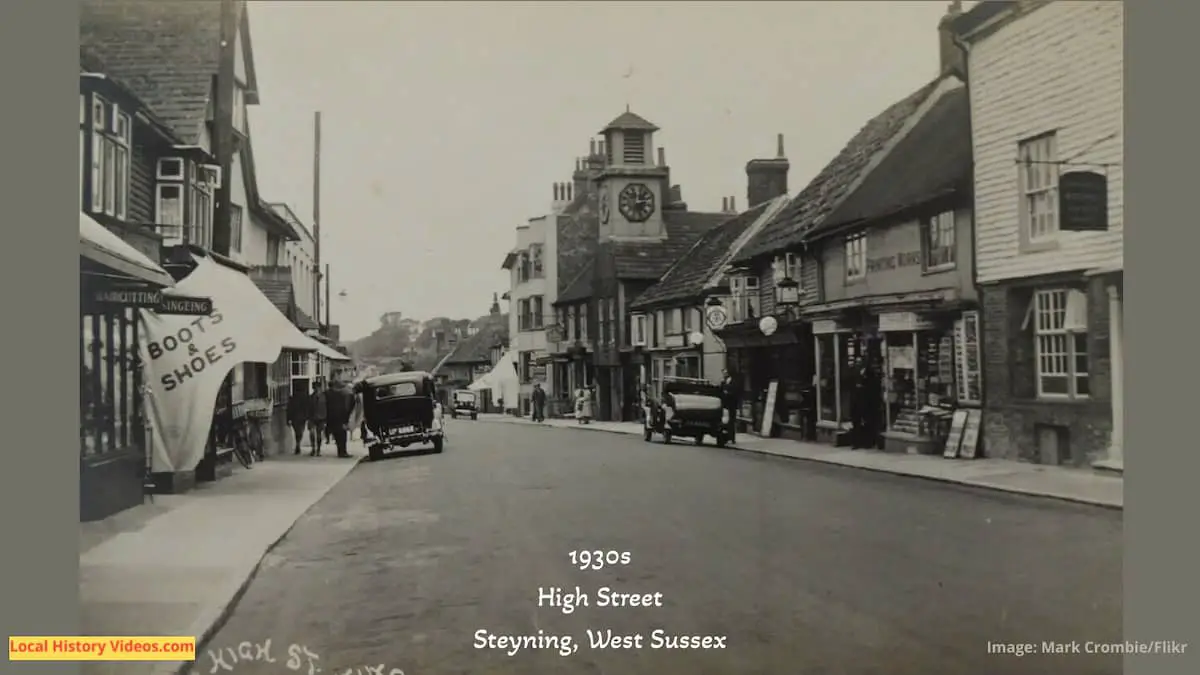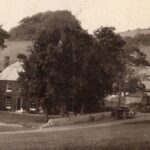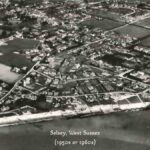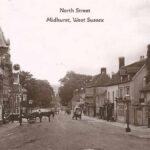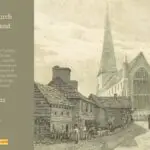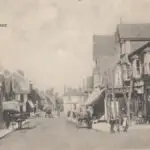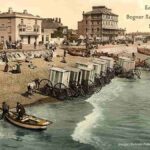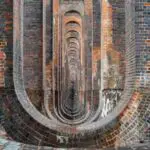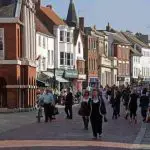Glimpse history through old images of Steyning, West Sussex, England.
Domestic Science 1953
14 year old Pat Willard was one of the pupils of the County Secondary School being trained in the home economics kitchen and flat. Their equipment included coal ranges, electrical stoves, parafin stoves, and gas cookers.
Headmaster Edwin Crawford comes in to allow the narrator yet more excrutiating observations about the role of the ‘future housewives’.
School Flat (1953) – British Pathé on YouTube
Rex Hays 1959
Rex Hays was a well known professional modelmaker, with examples of his work exhibited in British and US museums during his lifetime and commissions from famous car racers and royalty.
He was also an author, historian, and broadcaster.
This item, filmed in his home, shows the 1/20th scale model cars he had made for Beauleiu car museum.
Precision Models (1959) – British Pathé on YouTube
A bit of Steyning History
Extract from: “A History of the Castles, Mansions, and Manors of Western Sussex” by Dudley George Cary Elwes and Charles John Robinson
Published in 1876
Pages 213 – 215
THIS place is thought by some to have derived its name from a Roman road
Steyne , or Stone Street – on which it is situated , but Mr. Lower considers that
it is more likely to mean the settlement of Staen and his family .
The earliest
notice of it occurs in the will of King Alfred , by whom it was bequeathed as ” the
vill of Steningham , ” to Ethelwald , his brother’s son .
In the Domesday Survey
it is mentioned among the possessions of Edward the Confessor , which he had
bestowed upon the Abbey of Fescamp , in Normandy , but a portion of it was ,
at the date of the Survey , in the hands of William de Braose , the lord of
Bramber .
King William confirmed to the Abbey its rights in Steyning , and these ,
in spite of encroachments by the powerful family of de Braose , were retained
by the alien Abbey until its suppression in 1415.
The manor was then transferred
by Henry V. to Sion Priory , but , on the dissolution of religious houses , again
reverted to the Crown , and seems soon afterwards to have become the property
of the Earls of Arundel , from whom it has descended to their representative ,
the Duke of Norfolk .
In Steyning are included several manors , the most important being that of
CHARLTON , which was held successively by the Abbeys of Fescamp and Sion ,
after having been enjoyed for a short interval by Sir John Cornwall , and Elizabeth
his wife . In 1538 Agnes Jordan , Abbess , by indenture demised the manor of
Charlton cum Ashurst to William Pellatt and his assigns , for 99 years , at the
yearly rent of £ 12 16s . 8d .
Three years afterwards , at the Dissolution , the lessee obtained a grant of the
manor which his successor , Thomas Pellatt , sold to Dorothy Lewknor , of Kingston
Bowsey , whose sons , Edward and Thomas Lewknor , alienated it to Sir Thos .
Shirley , of Wiston . In 1634 it appears by a fine to have belonged to Lionel
( Cranfield ) Earl of Middlesex , and soon afterwards to Jonn , Earl of Thanet ,
who , in 1652 , sold it to John Eversfield , Esq . , for £ 4.500 . The Eversfields
retained possession of Charlton until 1815 , when Charles Eversfield , Esq . ,
alienated it to Charles Goring , Esq . , from whom it has descended to the Rev.
John Goring , the present proprietor . Charlton Court was occupied by the
families of Pellatt and Eversfield , until the beginning of the last century , when
it was given up in favour of Denne Place , Horsham , which , like Charlton , went
through the heiress of the Eversfield family to William Markwick , who assumed
the former name .
WICKHAM is an ancient manor which , in 1307 , was settled by Margaret ,
widow of William Graundyn , on John de Lychepole , and in 1313 upon John de
Ifield . The said Margaret died seised of it in 1330 , and three years later it is
said to have belonged to John de Wickham and Hawise his wife . Before the
close of the 14th century the manor was divided , one moiety being included
among the possessions of Reginald de Cobham , in 1397 , and in 1404 , Hugh
Queeche died seised of the other moiety . It is difficult to trace the descent of
the property with much accuracy , but one moiety of the manor was granted by
Sir William Percy and others , in 1406 , to John Norton , who probably resided
upon it . A little later ( 1427 ) , William Hystede and Alice his wife acquired a
moiety , and in the following century ( 1549 ) , the manor belonged to Richard
Farnfold , Esq . , and went , as his daughter’s dower , to Sir Edward Culpeper , of
Wakehurst . In the early part of last century the demesne lands were
purchased by Richard Trevor , Bishop of Durham , and from him have descended
to the Rt . Hon . H. B. W. Brand , Speaker of the House of Commons .
The manor of WAPPINGTHORNE is mentioned in Domesday , being at its
date in the tenure of William Fitzmanne , and of the value of £ 4 . Before the
thirteenth century it had passed into the hands of the family of Bonet , by whom
it was retained until the year 1351 , as appears by the annexed pedigree . The
Bonets were , however , only the mesne lords , and upon their extinction the manor
continued with the chief lords , the Dukes of Norfolk , who had inherited their
right from the Barons of Bramber . Its history is not very clearly traced during
the 16th century , but in 1606-7 , John Leedes , Esq . , died seised of the manor ,
which , in his Inquisition is described as holden of the Castle of Bramber by
knight’s service . Sir Thomas Leedes , K.B. , his son and heir , succeeded to it ,
and soon afterwards it passed , by sale or otherwise , to Edward Goring , second
son of Sir Henry Goring , of Burton , whose descendant , Sir Charles F. Goring ,
Bart . , now enjoys it .
The mansion was long ago converted into a farm house , but in the excellent
brickwork and stone – mullioned windows , there are evidences of its former
importance , and in the defaced armorial shield , above the portico , there are traces
of its occupation by a family of gentle birth .
The Vicarage house is said by Mr. Lower to be ” a good specimen of a parochial manse , with some curious carved wainscoting , having the arms of St.
Richard , of Chichester , Fitz James , Bishop of London , and the arms and
cognizances of Henry VIII . and Queen Catherine . ”
The church has still further
claims to notice , for , although it is only a fragment of what was intended to have
been a very noble structure , it possesses many very interesting features .
Much
of the church is Early English in style , but the piers of the tower arch are
Norman , and the capitals of some of the pillars and a rude bas – relief are of still
higher antiquity .
The town itself , albeit of sufficient importance in 1278 to return two
members to Parliament ( which privilege it retained till the Reform Act ) , has ,
from a variety of causes , and especially from the recession of the sea , become
very insignificant in size .
Its one long street contains a few timbered houses ,
the most interesting of which is the old ” Brotherhood Hall , ” within which is
the Grammar School , founded by William Holland , ald . of Chichester , in 1614 .
Gatwick , an ancient residence near the church , gave its name to a family , one
member of which is mentioned in the Nonæ Return , made in 1341.
Among
the burgesses occur the names of Bowyer , Farnfold , Filmer , Goring , Honeywood ,
Onslow and Shirley , and it would seem that from Sir John Honeywood ( M.P.
1784 to 1791 ) , the Duke of Norfolk purchased the borough with its seat in
Parliament .
More about West Sussex
- Old Images of West Sussex, England
- Old Images of Worthing, West Sussex
- Old Images of Steyning, West Sussex
- Old Images of Selsey, West Sussex
- Old Images of Midhurst, West Sussex
- Old Images of Horsham, West Sussex
- Old Images of Crawley, West Sussex
- Old Images of Bognor Regis, West Sussex
- Old Images of Arundel, West Sussex
- Old Images of Haywards Heath, West Sussex
- Old Images of Chichester West Sussex
- West Sussex: Local History Resources

